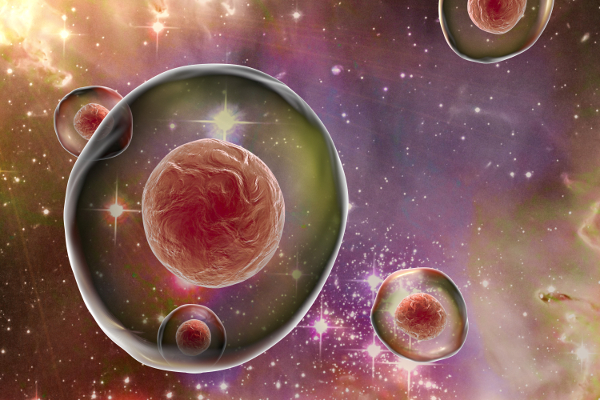NASA GeneLab Commences Countdown To Combine Space, Data, Analytics
Project will provide window to human biology and health
By Leslie Mertz

A little more than three years ago, NASA introduced GeneLab, an initiative to collect data from pioneering biology experiments in the microgravity of space that generate enormous amounts of genomics and other omics data, and provide access to not only the mass of information, but also the data-mining and -analysis tools to help make the data as useful as possible now and in the years to come.
To learn more about GeneLab and its progress, IEEE Life Sciences caught up with GeneLab Project Manager Michael Skidmore while he was attending the 2016 meeting of the American Society for Gravitational and Space Research (ASGSR) in late October.
 GeneLab Project Manager Michael Skidmore. Photo courtesy of NASA’s Ames Research Center in Silicon Valley.
GeneLab Project Manager Michael Skidmore. Photo courtesy of NASA’s Ames Research Center in Silicon Valley.
IEEE Life Sciences: How would you describe NASA’s GeneLab?
Michael Skidmore: In the broadest scope, GeneLab is working to collect omics data, such as genomics, transcriptomics, proteomics, and metabolomics, that indicate what is going on at a cellular level in response to the challenges that an organism is facing. This data will be available to give the research community a chance to look at those responses at the cellular level and at the genetic level, and use them both to look at what might happen to astronauts as they leave the lower Earth orbit, and to look down at Earth and address disease here.
IEEE Life Sciences: Would you provide a little more detail on why microgravity experiments are important?
MS: We do this work in microgravity so that we’re looking at what happens to tissues and study animals (in these conditions), because what happens to them is predictive of what’s going to happen to astronauts. In other words, it’s a way to make sure that we give the very best protection we can to our astronauts.
A more global answer to that question is that space flight is in many ways a good analog of normal human aging. In space, the physiology of animals and of humans changes: They experience accelerated bone loss and alterations in the visual field, for instance, and by looking at them in microgravity, we can look at similar disease states or deficits as people get older here on Earth. And we can look at all those age-related changes at once. That’s valuable because all of the systems in your body react off of changes in other systems. For instance, your immune system changes affect your circulatory system, which affects the nervous system, so there are numerous feedback loops that are going on as the body adapts.
IEEE Life Sciences: Will all of these experiments be conducted on the International Space Station (ISS)?
Skidmore: Some of the experiments are on ISS, but they can be on other NASA vehicles as well. And there is even some data that resulted from NASA experiments in association with the Russian space program. In addition, data can come from ground-based studies that are supportive of the space-based research, because it’s often quite useful to have the ground-based studies to compare to what we’re finding in space.
IEEE Life Sciences: How far along is GeneLab?
MS: Phase one was to set up a fully functional data repository (1) where we provide the data that is collected by researchers and we also collect in a very meticulous manner the related metadata, so that it’s useful for somebody looking at the data 30 to 50 years from now when the original researchers are likely no longer around. GeneLab is also making this data available without restriction worldwide, and our goal there is to take all of this omics data, including everything that’s collected for any particular experiment or flight, and make all of that available online to anybody so it’s an open-science resource for the purpose of stimulating new concepts and new hypotheses.
I’m reporting here at the ASGSR meeting that we’ve done just that. Our data system is online, and right now we’re at 81 datasets, and have been increasing at about 10-15 datasets every month or so. Since we’ve started tracking downloads from the GeneLab repository in April of 2015, we’ve had more than 10,000 downloads of studies and that’s averaging about 1,000 file downloads a month, which is roughly 3 terabytes of data a month. As the repository increases in size and in the number of studies made available, I expect that rate will go up.
IEEE Life Sciences: What are the next phases?
MS: In phase two, we’re continuing to collect data and we’re developing a Google-like search capability, so you can enter our website and search data on our site or any other site that we’re federated with. As we move into phase three, we’ll start to establish a virtual workspace where researchers can go to find data and then use biocomputational tools that we’ll have available so they can work singly or in groups to do analysis. Finally, the end goal of phase four is to build on those capabilities and make them more robust and usable.
IEEE Life Sciences: Will GeneLab be developing the biocomputational tools?
MS: The GeneLab mandate doesn’t involve the development of tools. Other people will be developing them. In fact, Space Life and Physical Sciences (SLPS) Space Biology Division just announced six research awards in October, and three of them went to researchers who are working on those kinds of tools (2) that will come into GeneLab and will eventually be openly available in the virtual workspace.
IEEE Life Sciences: What are the challenges as GeneLab moves forward?
MS: One of the big questions that I have for the research community is what are the appropriate boundaries for GeneLab. For instance, should we be expanding to other services that would be useful to the research community, or should we expand our data that we store to perhaps include data that is descriptive of what’s going on with the organism when the omics data was collected? Another aspect is that we’re working to conform to the presidential open-data policy that says data must be made available in standards that are appropriate to the community. We are working to ensure that our data is “available” in compliance with the presidential direction, and also with community standards. This science is evolving very rapidly which requires GeneLab to adapt and respond just as rapidly. Right now, we have 81 datasets so we can adjust to changing standards more easily. But what happens when we have 8,000 datasets and we find there’s a new community standard to store the omics data? We need to be vigilant and remain ready to respond.
We want to make sure we build something that’s useful for the research community and that provides them the tools, the capabilities, and the services that enable them to do the best research possible.
Leslie Mertz is a freelance science writer and author living in northern Michigan.
References
- NASA, “NASA GeneLab data repository.”
Accessed on October 27, 2016. - NASA, “GeneLab proposal winners rely on open science data to advance space biology,” October 21, 2016.
Accessed on October 27, 2016.






